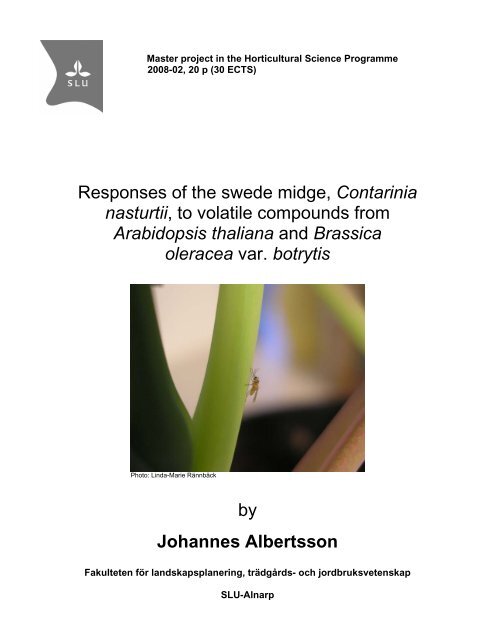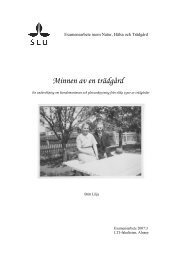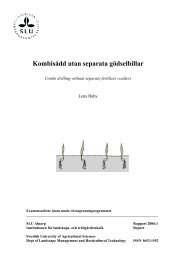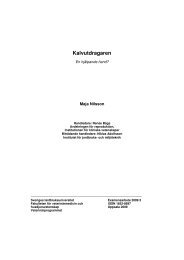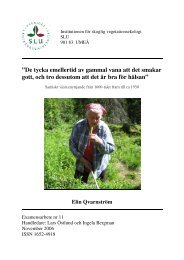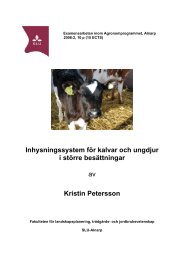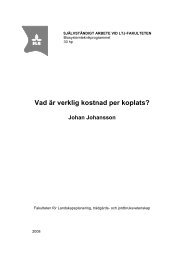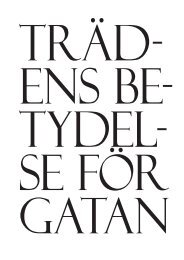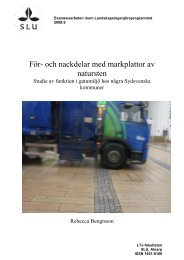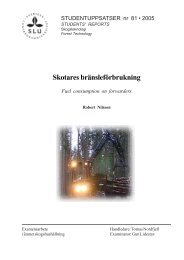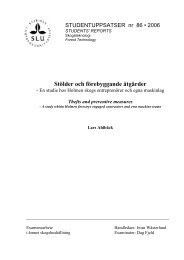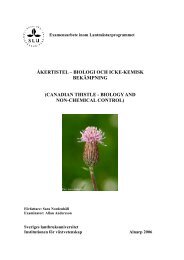Biology swede midge - SLU
Biology swede midge - SLU
Biology swede midge - SLU
Create successful ePaper yourself
Turn your PDF publications into a flip-book with our unique Google optimized e-Paper software.
Master project in the Horticultural Science Programme<br />
2008-02, 20 p (30 ECTS)<br />
Responses of the <strong>swede</strong> <strong>midge</strong>, Contarinia<br />
nasturtii, to volatile compounds from<br />
Arabidopsis thaliana and Brassica<br />
oleracea var. botrytis<br />
Photo: Linda-Marie Rännbäck<br />
by<br />
Johannes Albertsson<br />
Fakulteten för landskapsplanering, trädgårds- och jordbruksvetenskap<br />
<strong>SLU</strong>-Alnarp
PROJECT INFORMATION<br />
This report is a result of a master thesis (30 ects) carried out at the department of Plant<br />
Protection <strong>Biology</strong> within the Horticultural programme at the Swedish University of<br />
Agricultural Sciences. Tina Boddum and Ylva Hillbur were supervisors and Peter<br />
Anderson was the examiner.<br />
2
ABSTRACT<br />
The <strong>swede</strong> <strong>midge</strong>, Contarinia nasturtii, is a serious gall-forming insect pest of most<br />
cultivated Brassicaceae such as cauliflower and cabbage. Arabidopsis thaliana, also a<br />
Brassicaceae, is a well-known model plant for which the genome is sequenced and<br />
several well-characterized mutants and transgenic genotypes are available. Previous<br />
results indicate that odours from cauliflower attract C. nasturtii. In this study the<br />
responses of C. nasturtii to volatiles from cauliflower and Arabidopsis were tested in a<br />
four-arm and a y-tube olfactometer. The results indicate that females are attracted to<br />
volatiles both from cauliflower and Arabidopsis. Males on the other hand were not<br />
attracted. This study also suggests improvements for the y-tube as well as a four-arm<br />
olfactometer setup.<br />
SAMMANFATTNING<br />
Kålgallmyggan, Contarinia nasturtii, är en skadegörare på flertalet odlade grödor<br />
tillhörande familjen Brassicaceae så som blomkål, vitkål och broccoli. Arabidopsis<br />
thaliana, som också tillhör denna familj, är en viktig modellväxt eftersom dess genom<br />
helt är kartlagt och att en mängd väldokumenterade mutationer och transgena genotyper<br />
finns tillgängliga. Tidigare studier har indikerat att C. nasturtii är attraherad av doft från<br />
blomkål. I det här arbetet undersöker vi, med hjälp av en fyr-arms olfaktometer och en yrörs<br />
olfaktometer, om C. nasturtii är attraherad av flyktiga ämnen från blomkål och<br />
Arabidopsis. Resultaten från detta arbete pekar på att honor attraheras av doft från båda<br />
dessa växter. Hannarna attraherades däremot inte. Detta arbete föreslår också<br />
modifikationer och förbättringar för y-rörs samt fyr-arms olfaktometrarna.<br />
3
INTRODUCTION............................................................................................................. 5<br />
Life cycle ........................................................................................................................ 5<br />
Host plant finding ........................................................................................................... 5<br />
Control of C. nasturtii..................................................................................................... 6<br />
Arabidopsis .....................................................................................................................7<br />
HYPOTHESIS................................................................................................................... 8<br />
MATERIALS AND METHODS ..................................................................................... 8<br />
Insect material.................................................................................................................8<br />
Plant material ..................................................................................................................9<br />
Four-arm olfactometer bioassay ..................................................................................... 9<br />
Y-tube olfactometer bioassay ....................................................................................... 11<br />
STATISTICS................................................................................................................... 12<br />
RESULTS ........................................................................................................................ 12<br />
Four-arm olfactometer .................................................................................................. 12<br />
Y-tube olfactometer ...................................................................................................... 14<br />
DISCUSSION .................................................................................................................. 15<br />
ACKNOWLEDGEMENTS ........................................................................................... 18<br />
REFERENCES................................................................................................................ 19<br />
4
INTRODUCTION<br />
The <strong>swede</strong> <strong>midge</strong>, Contarinia nasturtii (Kieffer) (Diptera: Cecidomyiidae) is a serious<br />
pest on cruciferous crops in many brassica-growing regions (Kikkert et al., 2006). Host<br />
plants include cruciferous weeds and most cultivated crucifers such as broccoli,<br />
cauliflower, cabbage and Brussel sprouts (Stokes, 1953; Hallett, 2007). The larva causes<br />
the damage when it feeds near the growing point of the plant. Symptoms include gall-like<br />
distortions, deformed plant tissue, and corky brown scars. Adult gall <strong>midge</strong>s are yellow to<br />
light brown and 1.5-2 mm long. Larvae are white to yellow and 2-2.5 mm long<br />
(Readshaw, 1966).<br />
Life cycle<br />
C. nasturtii overwinters in the soil as larva in spherical cocoons (Readshaw, 1966). At the<br />
end of May or beginning of June the larvae start to pupate and emerge. After emergence<br />
the adults mate and the female starts to search for a suitable host plant for oviposition<br />
(Madsen & Hansen, 2006). The female lays about 100 white eggs in clusters of 2-50 that<br />
hatch after a few days. The larvae feed on the plant tissue for 4-10 days and then leave<br />
the plant by falling down to the soil. Depending on temperature, humidity and day length<br />
the larvae either pupate to develop the next generation, or enter diapause (Readshaw,<br />
1966). In Sweden there are three overlapping generations each year (Jönsson et al.,<br />
2007).<br />
Host plant finding<br />
Insects use a predictable sequence of behaviour when selecting a host plant<br />
(Schoonhoven et al., 2005). The sequence usually begins with random flying or walking<br />
and ends with the acceptance of the host plant. As the sequence progresses the intensity<br />
and number of cues from the host plant increase. Host location of phytophagous insects is<br />
mediated by a combination of visual and olfactory cues (Schoonhoven et al., 2005). The<br />
relative importance of the two varies between species and distance to the plant. Currently<br />
there is no clear evidence that C. nasturtii uses plant volatiles to mediate host finding.<br />
However, in a previous study, C. nasturtii males responded strongly to plant volatiles<br />
5
from cauliflower (Möllerström, unpublished data). Mated females were also attracted to<br />
cauliflower volatiles but not as strongly as males. Host plant volatiles have also been<br />
shown to play an important role in host finding for several other Cecidomyiidae species<br />
e.g. Dasinuera tetensi (Crook & Mordue, 1999), Dasinuera mali (Galanihe & Harris,<br />
1997), Dasinurea brassicae (Pettersson, 1976) and Sitodiplosis mosellana (Birkett et al.,<br />
2004). In crucifers and related plant families glucosinolates are thought to serve as a first<br />
line of defence against a variety of invading insects (Schoonhoven et al., 2005).<br />
Hydrolysis of glucosinolates, forming volatile isothiocyanates, takes place at low rate<br />
during normal catabolism but increase rapidly when plant tissues are ruptured or<br />
wounded (Schoonhoven et al., 2005). These compounds are not only acting as defence<br />
compounds, they also play a key role in host selection for several crucifer specialists like<br />
the cabbage aphid, Brevicoryne brassicae (Nottingham et al, 1991), and the seed weevil,<br />
Ceutorhynchus assimilis (Blight et al., 1995). Additional, not yet identified compounds in<br />
crucifers may also play an important role in host plant selection for insects (Alan &<br />
Renwick, 2002).<br />
Control of C. nasturtii<br />
C. nasturtii is hard to control due to its short lifecycle and many generations. Insecticides,<br />
like pyrethroids can be applied to control them, but there are also many other cultural<br />
strategies available to lower the damage (Jönsson et al., 2007). The Swedish Board of<br />
Agriculture recommend the following measures; at least three year crop rotation, no rape<br />
seed next to cabbage fields, and as long a distance as possible (several hundred meters)<br />
between early and late batches of cabbage (Jönsson et al, 2007). Another culture strategy<br />
to decrease C. nasturtii damage is to use exclusion fences. An experiment made with<br />
these fences in Switzerland reduced damage caused by C. nasturtii significantly (Wyss &<br />
Daniel, 2004). Since the sex pheromone of C. nasturtii is identified there is also a<br />
possibility to develop an easy-to-use monitoring system (Hillbur et al., 2005).<br />
Other control methods, including resistant cultivars and transgenic plants can and may<br />
be explored in the future (Wu et al., 2006). Resistance to insects in crop cultivars is<br />
caused either by biochemical or morphological features (Diarisso et al., 1998). One<br />
example of a morphological feature is the resistance of some sorghum cultivars to the<br />
6
sorghum <strong>midge</strong>, Stenodiplosis sorghicola. In these genotypes the spikelets are closed<br />
when the female sorghum <strong>midge</strong>s are active and oviposition is thus prevented (Diarisso et<br />
al., 1998). The resistance of several wheat cultivars to the wheat <strong>midge</strong>, Sitodiplosis<br />
mosellana is however caused by biochemical features. When attacked by the larvae the<br />
resistant cultivars react by increasing the production of phenolic acids in combination<br />
with a local hypersensitive reaction on the seed surface (McKenzie, 2002). The defence<br />
mechanism reduces survival up to 99 % of the first-instar wheat <strong>midge</strong>s (Ganehiarachichi<br />
& Harris, 2007). An investigation on host plant susceptibility to C. nasturtii showed<br />
differences in susceptibility both between various cruciferous species and between<br />
cultivars (Hallett, 2007). The cause of the differences is not yet understood, but the fact<br />
that differences exist suggests possibilities to find genotypes conferring resistance to C.<br />
nasturtii.<br />
Another possible control method is the use of transgenic plants. The best example of<br />
this method is the engineered crop plants expressing Bacillus thuringiensis (Bt). Bt crops<br />
exhibit resistance to major insect pest in both corn and cotton and in 2004 such crops<br />
were grown on more than 22 million hectares (Ferry et al., 2006). Recent studies have<br />
also demonstrated that genetic transformation can be used to alter the emissions of a plant<br />
and render it more attractive to beneficial arthropods (Kappers et al., 2005; Schnee et al.,<br />
2006).<br />
Arabidopsis<br />
Arabidopsis thaliana belongs to the Brassicaceae family, which includes around 3350<br />
species worldwide (Koch et al., 2001). It is an important model plant for plant sciences<br />
and potentially also for ecological research (Schoonhoven et al., 2005). The genome has<br />
been fully sequenced and well-characterized mutants and transgenic genotypes are<br />
available. C. nasturtii host plants, like cauliflower and oilseed rape, are the closest<br />
agricultural relatives to Arabidopsis (Kliebenstein et al., 2001; Mitchell-Olds, 2001). In<br />
response to herbivores, Arabidopsis use similar transduction pathways as other crucifer<br />
plants, both when activating induced direct and indirect defence (Schoonhoven et al.,<br />
2005).<br />
7
HYPOTHESIS<br />
The properties of Arabidopsis and the indication of C. nasturtii attraction to host plant<br />
volatiles suggest a possibility for a new approach when searching for host plant volatiles.<br />
The aim of this study is therefore to verify the response of C. nasturtii to cauliflower and<br />
to test our hypothesis that plant volatiles from Arabidopsis attract C. nasturtii males and<br />
females. To test our hypothesis a bioassay suitable for testing C. nasturtii attraction to<br />
host plant volatiles had to be developed and evaluated.<br />
MATERIALS AND METHODS<br />
Insect material<br />
All the C. nasturtii used in the experiments originated from Switzerland. A C. nasturtii<br />
population had been kept at the Department of Crop Science, <strong>SLU</strong> Alnarp, since August<br />
2004. A new batch of C. nasturtii was incorporated into the rearing system in September<br />
2007 by collecting infested cauliflower plants from a field in Wädenswil, Switzerland.<br />
The infested plants were packed in plastic bags and transported to Sweden by car. In<br />
Alnarp, all plants were placed in large plastic boxes filled with 5-7 cm peat substrate. The<br />
boxes were placed in a climate chamber (25°C, 70% RH, LD 18:6 h) and covered with a<br />
white cotton cloth. Fourteen days after collection of the plant material the first <strong>midge</strong>s<br />
emerged from the substrate. Some <strong>midge</strong>s were used for experiments but most were used<br />
to infest new cauliflowers plants for the rearing.<br />
All <strong>midge</strong>s were reared in ventilated glass cages (30 x 30 x 35 cm) on cauliflower,<br />
Brassica oleracea var. botrytis, in the climate chamber described above. Every third day<br />
a new pot with cauliflower plants, with 6-9 true leaves, was placed in the cages and<br />
<strong>midge</strong>s were allowed to mate and oviposit on the plants. The infested plants were then<br />
removed, replaced with a new batch of plants, and incubated under the same climate<br />
condition as described above. Infested plants were misted every day with tap water.<br />
Approximately two weeks after oviposition, the larvae left the plants and pupated in the<br />
pot substrate. One-day prior to emergence, 17 to 18 days after oviposition, all the<br />
8
aboveground parts of the cauliflower plants were cut off. The pots with substrate and<br />
pupae were then placed in a cage where <strong>midge</strong>s were allowed to emerge.<br />
Males, one day old, and mated females were used in the bioassays. The females had<br />
been allowed to mate during the day before the bioassay. If some females exposed their<br />
ovipositor in the afternoon, indicating calling behaviour (Harris, & Foster, 1999), they<br />
were considered as unmated and discarded.<br />
Plant material<br />
In all bioassays with plant material, cauliflower plants (Brassica oleracea var. botrytis<br />
‘Vito’) with 7-10 true leaves, or 5-6 weeks old Arabidopsis (Arabidopsis thaliana<br />
‘Columbia’) served as odour sources. Cauliflower plants were grown two and two in pots<br />
(13 cm diam, 8 cm height) in a substrate consisting of 92% peat and gravel. Arabidopsis<br />
plants were grown two and two in pots (6 x 6 cm width, 5 cm height) in the same<br />
substrate. All pots were placed in a climate chamber (20°C, 60 % RH, and LD 16:8 h,<br />
250 μmol m -2 s -1 ) and treated with Steinernema feltiae, to control sciarid flies. In<br />
bioassays with plant material one cauliflower pot or two Arabidopsis pots were used. To<br />
minimize the volatiles released from the soil surface and the pot itself, they were covered<br />
with aluminium foil.<br />
Cauliflower plants for insect rearing were grown two and two in pots (13 cm diam, 8<br />
cm height) in a substrate consisting of 92% peat and gravel in a greenhouse with a<br />
temperature of 18-25°C and 10 hours of additional light (kb 1141, 400 W).<br />
Four-arm olfactometer bioassay<br />
The four-arm olfactometerer was based on the six-arm olfactometer described by<br />
Turlings et al. (2004). It consisted of a four–armed central choice chamber with one<br />
insect trapping bulb connected to each arm (Figure 1). Air was pumped into the<br />
olfactometer through two 250 ml gas-wash bottles, one with granulated activated<br />
charcoal and one with distilled water. After the gas-wash bottles, the inflow of air was<br />
divided into four lines of Teflon tubing via four flowmeters (BA-4AR, Kytölä, Muurame,<br />
Finland) to the test plants. The test plants were enclosed in polyethylene cooking bags<br />
9
(45 x 55 cm, Toppits, Melitta) and connected via Teflon tubes to each olfactometer arm.<br />
To avoid changes in air pressure a vacuum pump (Micro pump NMP 30 KNDC, 12 V,<br />
KNF Neuberger, Germany) was connected to the insect release point. The flow of<br />
incoming air was 0.9 l/min in each of the four Teflon tubes and the flow at the release<br />
point was 3.6 l/min. To get a uniform illumination and eliminate any visual distractions,<br />
the central choice chamber was covered with a white cotton cloth, placed 35 cm above<br />
the chamber and 35 cm to the sides. The olfactometer was illuminated with a mercury<br />
lamp (Tungsram 9L, HgMIF, 400/DM) placed 1.2 meter above the central choice<br />
Figure 1. The four-arm olfactometer<br />
bioasssay setup. Photo: Linda-Marie<br />
Rännbäck & Thilda Nilsson.<br />
chamber. After each experiment, all glassware was<br />
heated for 8 hours in 350 °C and all Teflon tubing<br />
and connections were washed once with 70 %<br />
ethanol to remove any odour contamination. The<br />
olfactometer was completely rebuilt after 10 days.<br />
The entire setup was disconnected and connections<br />
were, if spare ones existed, replaced with new ones.<br />
Tubing and all connections were placed over night<br />
in a box with 70 % ethanol. To get a more uniform<br />
illumination a white cylinder (50 cm diam and 20<br />
cm high) was placed around the central choice<br />
chamber.<br />
To evaluate the four-arm olfactometer setup, two<br />
experiments were made. In the first experiment, C.<br />
nasturtii males were tested against four empty bags.<br />
This experiment was made both with the initial and<br />
the rebuilt setup. In a second experiment, C.<br />
nasturtii males were tested against one bag,<br />
containing a cauliflower pot and three empty bags.<br />
The second experiment was only made using the<br />
rebuilt setup. In both experiments males were<br />
10
eleased simultaneously using a glass tube with removable cotton plugs at each end. All<br />
experiments lasted for two hours and were made between 10 pm to 2 am. Insects were<br />
only tested once.<br />
Y-tube olfactometer bioassay<br />
The y-tube olfactometer consisted of a y-shaped glass tube with an entry arm (14 cm<br />
long, 22 mm i.d) and two side arms (14 cm long, 22 mm i.d.). Both arms of the y-tube<br />
were connected to a polyethylene cooking bag (45 x 55 cm, Toppits, Melitta) which<br />
contained the odour source. Air was pumped into the olfactometer through two 250 ml<br />
gas-wash bottles, one with granulated activated charcoal and one with distilled water.<br />
After the gas-wash bottles the inflow of air (0.6 l/min) was divided into two lines of<br />
Teflon tubing via two flowmeters (BA-4AR, Kytölä, Muurame, Finland) to the bags.<br />
Visual cues were excluded in the olfactometer setup by placing the y-tube in a box (40 x<br />
40 x 40 cm) covered with a white cotton cloth. The olfactometer was illuminated with a<br />
lamp (Massive, 906609, 400 W) placed behind the cloth and 30 cm in front of the two<br />
side arms.<br />
A single C. nasturtii male was introduced into the tube and observed until he made a<br />
Figure 2. The female y-tube olfactometer bioassay<br />
setup. The male setup did not have the insect trapping<br />
bulbs.<br />
choice or until 5 min had elapsed. Males<br />
that did not choose a side arm within 5<br />
min were recorded as ‘no choice’. When<br />
half of the males had been tested in each<br />
batch the y-tube and the odour source<br />
was turned to avoid any directional<br />
effects. To test if C. nasturtii males were<br />
attracted to cauliflower or Arabidopsis,<br />
the attraction of a bag containing a<br />
cauliflower pot or a Arabidopsis pot was<br />
compared to the attraction of an empty<br />
bag. To evaluate the y-tube olfactometer<br />
11
setup a control experiment was made with one empty bag connected to each side arm. All<br />
the experiments with males were made between 10 am and 1 pm.<br />
In the female y-tube olfactometer setup an insect-trapping bulb was connected to each<br />
side arm (Figure 2). The modification was made to be able to run experiments during<br />
several hours. The females were released simultaneously by placing a glass tube, with 20-<br />
25 females, in the entry arm. To avoid females from escaping the glass tube was covered<br />
with an insect net at the end facing outwards. The attraction of C. nasturtii females to<br />
cauliflower or Arabidopsis was tested by comparing a bag containing cauliflower or<br />
Arabidopsis to an empty one. All the experiments with females lasted for 16 hours and<br />
started 5 pm. The light was on between 5 pm and 8 pm. After each experiment, all<br />
glassware was heated for 8 hours in 350 °C and all Teflon tubing and connections were<br />
washed once with 70 % ethanol to remove any odour contamination.<br />
STATISTICS<br />
Only those insects that made a choice were included in the statistical analyses. To test the<br />
difference between the arms in both the y-tube olfactometer and the four-arm<br />
olfactometer a chi square test was performed on the data from each bioassay (Zar, 1999).<br />
RESULTS<br />
Four-arm olfactometer<br />
In both the initial and the rebuilt four-arm olfactometer setup, most responding males<br />
made the choice within the first five minutes of the bioassay. In the initial control<br />
experiment there was a significant difference between the arms (chi 2 = 23.59, p < 0.001).<br />
There was still a significant difference between the arms when the experiment was<br />
repeated in the rebuilt setup (chi 2 = 12.79, p < 0.01) although another arm was preferred<br />
(Figure 3B). When cauliflower was tested against three controls, significantly more males<br />
(chi 2 = 7.91, p < 0.05) choose one of the controls (Figure 3C). Only 8 out of 54 males<br />
chose the cauliflower arm. The sample size and percentages of responding C. nasturtii in<br />
the four-arm olfactometer bioassays are presented in Table 1.<br />
12
Table 1. Sex, sample size (N) and percentages of responding C. nasturtii for the four-arm olfactometer<br />
bioassay.<br />
Bioassay (number of arms) Sex N Responding (%) Figure 3<br />
Initial Control (4) male 141 79 A<br />
Rebuilt Control (4) male 29 66 B<br />
Rebuilt Control (3) - Cauliflower (1) male 54 85 C<br />
A<br />
Number of males<br />
B<br />
Number of males<br />
C<br />
Number of males<br />
60<br />
50<br />
40<br />
30<br />
20<br />
10<br />
0<br />
12<br />
10<br />
8<br />
6<br />
4<br />
2<br />
0<br />
20<br />
18<br />
16<br />
14<br />
12<br />
10<br />
8<br />
6<br />
4<br />
2<br />
0<br />
Control Control Control Control<br />
Control Control Control Control<br />
Cauliflower Control Control Control<br />
Figure 3. Response of male C. nasturtii in the four-arm olfactometer bioassay. A) Initial control, chi 2 =<br />
23.59, p < 0.001, B) Rebuilt control, chi 2 = 12.79, p < 0.01, C) Rebuilt setup with one cauliflower arm and<br />
three control arms, chi 2 = 7.91, p < 0.05.<br />
13
A<br />
Number of males<br />
B<br />
Number of males<br />
C<br />
Number of males<br />
Y-tube olfactometer<br />
Almost all males (90 %) that made a choice made it within the first two minutes. The<br />
majority of the responding males flew into the side arms whereas nearly all responding<br />
females walked. The sample size and percentages of responding C. nasturtii in the y-tube<br />
olfactometer bioassays are presented in Table 2.<br />
Table 2. Sex, sample size (N) and percentages of responding C. nasturtii for the y-tube olfactometer<br />
bioassay.<br />
Bioassay Sex N Responding (%) Figure 4<br />
Control - Control male 20 90 A<br />
Cauliflower - Control male 61 85 B<br />
Arabidopsis - Control male 51 78 C<br />
Cauliflower - Control female 62 90 D<br />
Arabidopsis - Control female 37 86 E<br />
15<br />
10<br />
5<br />
0<br />
30<br />
25<br />
20<br />
15<br />
10<br />
5<br />
0<br />
30<br />
25<br />
20<br />
15<br />
10<br />
5<br />
0<br />
Control Control<br />
Arabidopsis Control<br />
Cauliflower Control<br />
D<br />
Number of females<br />
E<br />
Number of females<br />
25<br />
20<br />
15<br />
10<br />
5<br />
0<br />
40<br />
30<br />
20<br />
10<br />
0<br />
Arabidopsis Control<br />
Cauliflower Control<br />
Figure 4. Response of C. nasturtii in the y-tube olfactometer bioassay. A) Control-control (male), chi<br />
14<br />
2 =<br />
0.22, p > 0.05, B) Arabidopsis-control (male), chi 2 = 1.6, p > 0.05, C) Cauliflower-control (male), chi 2 = 0,<br />
p > 0.05, D) Arabidopsis-control (female), chi 2 = 3.13, p > 0.05. E) Cauliflower-control (female), chi 2 =<br />
2.57, p > 0.05.
There were no significant differences between the arms when two controls – empty<br />
arms – were compared (chi 2 = 0.22, p > 0.05; Figure 4A). When males were given the<br />
choice between cauliflower and control exactly 50 % of the males chose the control arm<br />
(chi 2 = 0, p > 0.05 ; Figure 4B). More males chose the arm with Arabidopsis than the<br />
control arm (Figure 4C), but the difference was not significant (chi 2 = 1.6, p > 0.05).<br />
Two y-tube olfactometer bioassays were made with females. In the first, females were<br />
given the choice between cauliflower and control. Cauliflower showed a tendency to be<br />
more attractive than control (Figure 4D), but the difference was not significant (chi 2 =<br />
2.57, p > 0.05). In the last bioassay, Arabidopsis attracted far more females than the<br />
control, 21 out of 32 (Figure 4E). However, the difference was not large enough to be<br />
significant (chi 2 = 3.13, p > 0.05).<br />
DISCUSSION<br />
The results from this study suggest that C. nasturtii females are attracted to plant volatiles<br />
from both cauliflower and Arabidopsis. A new approach for investigating C. nasturtii -<br />
host plant interactions could thus be developed. The method would test the attraction of<br />
C. nasturtii to transgenic or mutant Arabidopsis lacking certain volatile compounds. It<br />
would not only give the information about C. nasturtii attractiveness to a mutant or<br />
genetically modified Arabidopsis, but also hopefully the gene responsible for the<br />
attraction. This information could in a longer perspective be used for ecological studies<br />
and/or for traditional/transgenic breeding purposes (Turlings & Ton, 2006). In contrast to<br />
the females, the males did not show any clear attraction to either cauliflower or<br />
Arabidopsis.<br />
Initially, a four-arm olfactometer was used to test the behavioural response of C.<br />
nasturtii. However, the control bioassays showed significant difference between the arms<br />
both before and after the setup had been rebuilt. Therefore a decision was taken, two<br />
months into the study, to discard the four-arm olfactometer and instead use a y-tube<br />
olfactometer. The y-tube olfactometer is more time consuming to use because the insects<br />
are released one by one. This was not a problem when working with males since their<br />
response time was very short (see result). The females one the other hand had a much<br />
15
longer response time (data not presented). To be able to test the females within the time<br />
frame of this study a modification with insect trapping bulbs connected to each side arm<br />
was made. The modification made it possible to release females simultaneously without<br />
constant supervision.<br />
Different types of olfactometers have been used in several experiments to test insect<br />
behaviour (Pettersson, 1976; Turlings et al., 2004). The reason why the C. nasturtii males<br />
significantly chose one arm in our four-arm olfactometer setup is not yet clarified. One<br />
possible explanation could be that the plastic connections between the Teflon tubing were<br />
contaminated with some repellent or attractant. However, the Teflon tubing and the<br />
connections were cleaned with 70 % ethanol between each test, so the compounds must<br />
then be resistant to such treatment. Another explanation could be visual cues. However,<br />
the light intensity was measured several times with a luxmeter (Gossen, 1.70-291,<br />
Germany) to verify the uniformity and no difference in light intensity was seen between<br />
the four arms.<br />
To get the four-arm olfactometer to work properly the following improvements are<br />
proposed; replace the polyethylene cooking bags with glass cylinders, use press-fit<br />
connections when connecting the glass cylinder with Teflon tubing, replace plastic<br />
connections between Teflon tubing with Teflon connections, use a light bulb as Turlings<br />
et al (2004) to get a more uniform illumination, and place the setup in a climate chamber<br />
with the possibility to have constant background illumination, temperature, and humidity.<br />
In the y-tube olfactometer setup used in this study, C. nasturtii males did not show any<br />
behavioural response to plant volatiles from cauliflowers. The result is contradictory to<br />
results by Möllerström (unpublished data), where C. nasturtii males flew significantly<br />
more to arms containing cauliflower plants in a four-arm olfactometer. Since the variety<br />
of the cauliflower is unknown in Möllerstöms study, it is not possible to rule out<br />
differences in volatile composition between the varieties. It is also possible that the<br />
difference between the studies is due to other reasons such as contamination of the setup.<br />
However, since we didn’t use any females in the y-tube olfactometer prior to the male<br />
bioassays and made several control bioassays, it is unlikely that our setup was<br />
contaminated.<br />
16
Growing conditions for the plants were also different between the studies. In our<br />
study, the plants used for the y-tube olfactometer bioassays were grown in a climate<br />
chamber with no occurrence of any herbivore insects. It is well known that plants<br />
attacked by herbivore insects increase the volatile production due to their induced direct<br />
and indirect defence (Kessler & Baldwin 2001; Dicke & Van Poecke, 2002). Hence, the<br />
contradictory results may depend on differences in herbivore damage of the tested plants.<br />
In other Cecidomyiidae species such as D. tetensi (Crook & Mordue, 1999), D. mali<br />
(Harris et al. 1996), and D. brassicae (Pettersson, 1976; Williams & Martin, 1986) no<br />
male attraction was found to host plant volatiles. However, Murchie et al. (1997) caught<br />
D. brassicae males in traps baited with synthetic secondary volatiles from crucifers. The<br />
conflicting results from the D. brassicae studies may indicate that factors, not yet known,<br />
could affect the behavioural response of male gall <strong>midge</strong>s to host plant volatiles. Such<br />
factors could perhaps be temperature, humidity, time of the day and light conditions since<br />
these factors affected male mating activity of S. mosellana (Pivnick, 1993). McNeil &<br />
Brodeur (1995) have also suggested that differences in mating success of Aphidius<br />
nigripes could depend on changes in atmospheric pressure. The strong D. brassicae male<br />
response to the traps could also indicate that the synthetic volatiles used as lures, or a<br />
volatile contamination in the trap, could be a component of the D. brassicae sex<br />
pheromone.<br />
Both D. tetensi (Crook & Mordue, 1999) and D. mali (Harris et al. 1996) have<br />
perennial host plants. Hence, the lack of response to host plant volatiles could be<br />
explained by the fact that they emerge directly below their host plants (Crook & Mordue,<br />
1999). However, this argument is not applicable to C. nasturtii since most of its host<br />
plants are annuals (Stokes, 1953). What benefit would a C. nasturtii male then have of<br />
detecting host plant volatiles? This question is difficult to answer because there are no<br />
studies made on C. nasturtii female behaviour after emergence. If the female only mates<br />
once, like Mayetiola destructor (Harris & Foster, 1999), and stays at the emergence place<br />
until she is mated, like Contarinia oregonensis (Miller & Borden, 1984), there are no<br />
obvious benefits for the male to fly to crucifers. However, if the female mates several<br />
times and/or fly to crucifers directly after emergence males would clearly have a better<br />
chance to find a mating partner.<br />
17
Regardless if females are to be tested with a y-tube olfactometer or with a four-arm<br />
olfactometer optimizations could be made to get better results. Evidently, it is important<br />
that the females are tested when they are in the right physiological state, hence searching<br />
for host plants. One factor influencing this behaviour is probably the mating status since<br />
only mated females responded to host plant volatiles in both D. brassicae (Pettersson,<br />
1976) and D. tetensi (Crook & Mordue, 1999). Our way to decide if a female is mated or<br />
not is not very accurate, since a virgin female does not call all the time. Therefore, a more<br />
accurate method has to be used which guarantee that mating has occurred. Another factor<br />
that could affect the result is the experimental period. Cecidomyiidae species like S.<br />
sorghicola only search actively for host plants between 8 am and 11 am (Diarisso et al.,<br />
1998). Hence, tests or observations that establish the time when the C. nasturtii are active<br />
should be performed. In our bioassays either two cauliflower plants or four Arabidopsis<br />
were used as an odour source. This study did not investigate the suitability of this number<br />
of plants, however since dose-response test with other insects have shown that volatile<br />
concentration affect their choice (Turlings et al., 2004), this is an important area to<br />
improve. Furthermore the plants used in the bioassays should be illuminated since several<br />
plants increase the odour release when exposed to increased light intensity (Gouinguene<br />
& Turlings, 2002). An additional optimization is to use filters that trap volatiles from the<br />
odour sources during the bioassay. If these filters are analysed they will detect variations<br />
among bioassays in volatile emissions from the tested plants (Turlings et al., 2004), and<br />
make the results more valid. If the suggested improvements and optimizations are made<br />
to the olfactometers and if more females are tested my personal opinion is that more<br />
convincing results could be achieved.<br />
ACKNOWLEDGEMENTS<br />
I would like to thank all the people that helped and inspired me in this project. Special<br />
thanks to my supervisors Ylva Hillbur and Tina Boddum. You two are probably the most<br />
positive people I ever met. I would also like to thank Elin Isberg and Linda-Marie<br />
Rännbäck for practical assistance with bioassays and insect rearing, and Peter Anderson<br />
for technical support. Finally I would like to thank Alexandra Nikolic and Joakim Ekelöf<br />
who I forced listen to gall <strong>midge</strong> chats during the whole study.<br />
18
REFERENCES<br />
Alan J., Renwick A. 2002. The chemical world of crucivores: lures, treats and traps.<br />
Entmologia Experimentalis et Applicata. 104: 35-42<br />
Birkett M.A., Bruce T.J.A., Martin J.L., Smart L.E., Oakley J., Wadhams L.J. 2004.<br />
Responses of female orange wheat blossom <strong>midge</strong>, Sitodiplosis mosellana, to wheat<br />
panicle volatiles. Journal of Chemical Ecology 30: 1319-1328<br />
Blight M.M., Pickett J.A., Wadhams L.J., Woodcook C.M. 1995 Antennal perception<br />
of oil seed rape, Brassica napus (Brassicaceae), Volatiles by the cabbage seed weevil<br />
Ceutorhynchus assimilis (Coleoptera, curculionidae). Journal of Chemical Ecology 21:<br />
1649-1664<br />
Crook D.J., Mordue A.J. 1999. Olfactory responses and sensilla morphology of the<br />
blackcurrant leaf <strong>midge</strong> Dasinuera tetensi. Entmologia Experimentalis et Applicata. 91:<br />
37-50<br />
Diarisso N.Y., Pendleton B.B., Teetes G.L., Peterson G.C., Anderson R.M. 1998.<br />
Spikelets flowering time: Cause of sorgum Resistance to Sorghum Midge (Diptera:<br />
Cecidomyiidae). Journal of Economic Entomology 91: 1464-1470<br />
Dicke M., Van Poecke, R.P.M. 2002. Signalling in plant-insect interactions: signal<br />
transduction in direct and indirect plant defence. In Plant signal transduction. pp. 289-<br />
316 Oxford University Press, Oxford<br />
Ferry N., Edwards M.G., Gatehouse J., Capell T., Christou P., Gatehouse A.M.R.<br />
2006. Transgenic plants for insect pest control: a forward looking scientific perspective.<br />
Transgenic Research 15: 13-19<br />
Galanihe L.D., Harris O. 1997. Plant volatiles mediate Host-finding behaviour of the<br />
apple leaf curling <strong>midge</strong>. Journal of Chemical Ecology 23: 2639-2655<br />
Ganehiarachichi G.A.S.M., Harris M.O. 2007. Oviposition behavior of orange wheat<br />
blossom <strong>midge</strong> on low- vs. high-ranked grass seed heads. Entmologia Experimentalis et<br />
Applicata. 123: 287-297<br />
Gouinguene S.P., Turlings C.J. 2002. The effects of Abiotic factors on induced volatile<br />
emissions in corn plants. Plant Physiology 129:1296-1307<br />
Hallett R.H. 2007. Host plant susceptibility to <strong>swede</strong> <strong>midge</strong> (Diptera: Cecidomyiidae).<br />
Journal of Economic Entomology. 100: 1335-1343<br />
Harris, M. O., Foster, S. P. 1999. Gall Midges, pp. 27-49, in J. Hardie and A.K. Minks<br />
(eds.). Pheromones of Non-Lepidopteran Insects Associated with Agricultural Plants.<br />
CABI Publishing, Wallingford, UK.<br />
19
Harris, M. O., Foster, S. P., Age K., Dana S. 1996. Sex pheromone communication in<br />
the apple leaf curling <strong>midge</strong> (Dasinuera mali). Proceedings of the New Zealand Plant<br />
protection Conference 49: 52-58<br />
Hillbur Y., Celander M., Baur R., Rauscher S., Haftmann J., Franke S., Franke W.<br />
2005. Identification of the sex pheromone of the <strong>swede</strong> <strong>midge</strong>. Journal of Chemical<br />
Ecology 31: 1807-1828<br />
Jönsson B., Hillbur Y., Albertsson J. 2007. Kålgallmyggan är en liten insekt som kan<br />
ge stora skador. Viola 20: 20-21<br />
Kappers, I.F., Ahoroni A., van Herpen T.W.J.M., Luckerhoff L.L.P., Dicke M.,<br />
Bouwmeester H.J. 2005. Genetic engineering of Terpenoid Metabolism attracts<br />
bodyguards to Arabidopsis. Science 309: 2070-2072<br />
Kessler A., Baldwin T. 2001. Defensive function of Herbivore-induced plant volatile<br />
emissions in nature. Science 291: 2141-2144<br />
Kikkert J. R., Hoepting C. A., Wu Q., Wang P., Baur R., Shelton A.M. 2006.<br />
Detection of Contarinia nasturtii (Diptera: Cecidomyiiae) in New York, a new pest of<br />
cruciferous plants in the United States. Journal of Economic Entomology 99: 1310-1315<br />
Kliebenstein D.J., Kroymann J., Brown P., Figuth A., Pedersen D., Gershenzon J.,<br />
Mitchell-Olds T. 2001. Genetic control of natural variation in Arabidopsis glucosinolate<br />
accumulation. Plant Physiology 126: 811-825<br />
Koch M., Bernhard H., Mitchell-Olds T. 2001. Molecular systematics og the<br />
Brassicaceae: Evidence from coding plastidic matK and nuclear Chs sequences.<br />
American Journal of Botany 88: 534-544<br />
Madsen, P. M. and Hansen, L. M. 2006. Krusesygegalmyggen. Grøn Viden. 167: 1-6.<br />
McKenzie R.I.H., Lamb R.J., Aung T., Wise I.L., Barker P., Olfert O. 2002.<br />
Inheritance of resistance to wheat <strong>midge</strong>, Sitodiplosis mosellana, in spring wheat. Plant<br />
Breeding 121: 383-388<br />
McNeil J.N., Brodeur J. 1995. Pheromone-mediated mating in the aphid parasitoid,<br />
Aphidius nigripes (Hymenoptera: Aphididae). Journal of Chemical Ecology 21: 959-972<br />
Miller G.E., Borden J.H. 1984. Reproductive behaviour of the Douglas-fir cone gall<br />
<strong>midge</strong>, Contarinia oregonensis (Diptera: Cecidomyidae). Canadian entomologist. 116:<br />
607-618.<br />
Mitchell-Olds T. 2001. Arabidopsis thaliana and its wild relatives: a model system for<br />
ecology and evolution. Trends in Ecology & Evolution 16: 693-700<br />
20
Murchie A.K., Smart L.E., Williams I.H. 1997. Responses of Dasinuera brassicae and<br />
its parasitoids Platygaster subliformis and Omphale clypealis to field traps baited with<br />
organic isothiocyanates. Journal of Chemical Ecology 23: 917-926<br />
Nottingham S.F., Hardie J., Dawson G.W., Alastair J.H., Pickett J.A., Wadhams<br />
L.J., Woodcock C.M. 1991. Behavioral and Electrophysiological responses of aphids to<br />
host and nonhost plant volatiles. Journal of Chemical Ecology 17: 1231-1242<br />
Pettersson J. 1976. Ethology of Dasinuera brassicae Winn (Dipt., Cecidomyidae). I.<br />
Laboratory studies of olfactory reactions to the host-plant. Symposia Biologica<br />
Hungarica 16: 203-208<br />
Pivnick K.A. 1993. Response of males to female sex pheromone in the orange wheat<br />
blossom <strong>midge</strong>, Sitodiplosis mosellana (Gehin) (Diptera: Cecidomyiidae). Journal of<br />
Chemical Ecology 19: 1677-1689<br />
Readshaw J. L. 1966. The ecology of the <strong>swede</strong> <strong>midge</strong>, Contarinia nasturtii (Kieff.)<br />
(Diptera, Cecidomyiide). 1.-Life-history and influence of temperature and moisture on<br />
development. Bulletin of entomological research 56:685-700.<br />
Schnee C., Köller T.G., Held M., Turlings T.C.J., Gershenzon J., Degenhardt J.<br />
2006. The products of a sigle maize sesquiterpene synthase form a volatile defense signal<br />
that attracts natural enemies of maize herbivores. Proceedings of the National Academy<br />
of Sciences of the United States of America 103: 1129-1134<br />
Schoonhoven L.M., van Loon J.J.A., Dicke M. 2005. Insect-plant biology. Second<br />
edition. pp 421. Oxford university press, Oxford<br />
Stokes B.M. 1953. The hostplant range of the <strong>swede</strong> <strong>midge</strong> (Contarinia nasturtii Kieffer)<br />
with special reference to types of plant damage. European Journal of Plant Pathology 59:<br />
82-90<br />
Turlings T. C. J., Davison, A. C., Keller, M. A. 2004. A six-arm olfactometer<br />
permittingsimultaneous observation of insect attraction and odour trapping. Journal of<br />
Chemical Ecology 29: 45-55.<br />
Turlings T. C. J., Ton J. 2006. Exploting scents of distress: the prospect of manipulating<br />
herbivore-induced plant odours to enhance the control of agricultural pests. Current<br />
Opinion in Plant <strong>Biology</strong>. 9: 421:427<br />
Williams I.H., Martin A.P. 1986. Evidence for a female sex pheromone in the brassica<br />
pod <strong>midge</strong> Dasinuera brassicae. Physiological Entomology 11:353-356<br />
21
Wu Q.J., Zhao J.Z., Taylor A.G., Shelton A.M. 2006. Evaluation of insecticides and<br />
application methods against Contarinia nasturtii (Diptera: Cecidomyiidae), a new<br />
invasive insect pest in the united states. Journal of Economic Entomology. 99: 117-122<br />
Wyss E., Daniel C. 2004. The effect of exclusion fences on the colonization of broccoli<br />
and kohlrabi by the Swede <strong>midge</strong>, Contarinia nasturtii (Diptera: Cecidomyiidae).<br />
Mitteilungen der Deutschen Gesellschaft für allgemeine und angewandte Entomologie<br />
14: 387-390<br />
Zar J.H. 1999. Biostatical Analysis. Fourth edition. pp 663. Prentice Hall, New Jersey<br />
22


